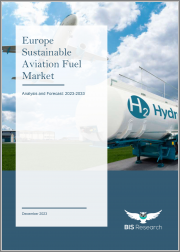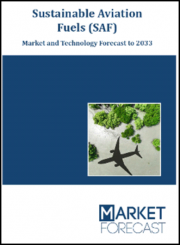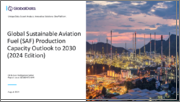
|
시장보고서
상품코드
1393901
유럽의 지속가능 항공 연료 시장 분석과 예측(2023-2033년)Europe Sustainable Aviation Fuel Market - Analysis and Forecast, 2023-2033 |
||||||
유럽의 지속가능 항공 연료 시장 규모는 2022년 9,690만 달러에서 예측 기간 중 58.03%의 CAGR로 추이하며, 2033년에는 182억 3,890만 달러 규모로 성장할 것으로 예측됩니다.
온실가스의 배출량을 삭감하고, 항공업이 기후변화에 미치는 영향을 경감하는 것이 급선무가 되고 있는 것으로 인해 지속가능 항공 연료(SAF)는 항공 업계에서 중요한 분야가 되고 있으며, 급속히 확대하고 있습니다. 정부, 항공회사, 기타 업계의 관계자는 지속가능성 목표의 달성을 위해 노력하는 가운데 SAF 시장에 한층 더 주력하고 자본을 투입하고 있습니다.
지속가능 항공 연료(SAF)에 대한 세계의 관심과 이용은 현재 극적으로 높아지고 있습니다. 기후변화 및 항공 업계에 의한 환경 악영향에 대한 우려의 확대에 의해 기존 제트 연료를 대신하는 보다 청정한 연료가 절실하게 요구되고 있습니다. 따라서 바이오매스, 식용유 잔류물, 수소 등의 지속가능 원료로부터 만들어지는 SAF는 실용적 솔루션을 제공해 왔습니다. 최신 기술과 협업은 SAF의 제조 능력을 향상시키고, 공급망을 합리화하고, 사업의 비용 다운을 실현하는 것으로 업계를 추진하고 있습니다.
유럽의 지속가능 항공 연료 시장을 조사했으며, 시장 개요, 기술 동향, 시장 성장에 대한 각종 영향요인 분석, 시장 규모의 추이·예측, 각종 구분·주요 국가별 상세 분석, 경쟁 구도, 주요 기업의 분석 등을 정리하여 전해드립니다.
| 주요 시장 통계 | |
|---|---|
| 예측 기간 | 2023-2033년 |
| 2023년 평가 | 1억 8,700만 달러 |
| 2033년 예측 | 182억 3,000만 달러 |
| CAGR | 58.03% |
시장의 분류
세분화 1 : 용도별
- 민간 항공
- 비즈니스·일반 항공
- 군용 항공
- 무인항공기(UAV)
세분화 2 : 연료 유형별
- 수소 연료
- 바이오연료
- 액체 연료
- 액화 가스 연료
세분화 3 : 제조 기술별
- Fischer-Tropsch Synthetic Paraffinic Kerosene(FT-SPK)
- Hydroprocessed Esters and Fatty Acids-Synthetic Paraffinic Kerosene(HEFA-SPK)
- Alcohol-to-Jet Synthetic Paraffinic Kerosene(ATJ-SPK)
- Synthetic ISO-Paraffin from Fermented Hydroprocessed Sugar(HFS-SIP)
- Catalytic Hydrothermolysis Jet(CHJ)
세분화 4 : 국가별
- 영국
- 독일
- 프랑스
- 기타
목차
제1장 시장
- 업계의 전망
- 지속가능 항공 연료 시장 : 개요
- 항공 업계에서 배출가스 규제 대책의 진화
- 새로운 제로 에미션 항공기 기술
- 현재 및 향후 기술 동향
- 진화하는 항공 추진 기술 : 배출량 감축을 향한 이동
- 지속가능 항공 연료 채택을 위한 중요한 성공 파라미터
- 사업 역학
- 사업 촉진요인
- 사업상 과제
- 사업 기회
- 사업 전략
제2장 지역
- 지속가능 항공 연료 시장(지역별)
- 유럽
- 시장
- 용도
- 제품
- 유럽(국가별)
제3장 시장 : 경쟁 벤치마킹·기업 개요
- 경쟁 벤치마킹
- 기업 개요
- BP p.l.c.
- Shell
- Neste
- SkyNRG
- Velocys plc
- TotalEnergies
제4장 조사 방법
KSA 23.12.15“The Europe Sustainable Aviation Fuel Market Expected to Reach $18.23 Billion by 2033.”
Introduction to Europe Sustainable Aviation Fuel Market
The Europe sustainable aviation fuel market was valued at $96.9 million in 2022 and is anticipated to reach $18,238.9 million by 2033, witnessing a CAGR of 58.03% during the forecast period 2023-2033. Due to the pressing need to lower greenhouse gas emissions and lessen the impact of aviation on climate change, the market for sustainable aviation fuel (SAF) has become an important and quickly expanding segment within the aviation industry. SAF, commonly referred to as biojet fuel, is produced using renewable energy sources, algae, and agricultural waste as sustainable feedstocks. It provides a competitive substitute for traditional jet fuel by cutting emissions of carbon dioxide and other pollutants to a great extent. Governments, airlines, and other industry players are putting more focus and capital into the SAF market as they work to meet their sustainability targets. The market for sustainable aviation fuel has enormous potential for innovation, teamwork, and good environmental impact. It has the ability to transform aviation and contribute to a more environmentally friendly future.
| KEY MARKET STATISTICS | |
|---|---|
| Forecast Period | 2023 - 2033 |
| 2023 Evaluation | $.187 Billion |
| 2033 Forecast | $18.23 Billion |
| CAGR | 58.03% |
Market Introduction
The concept of sustainable aviation fuel, or SAF, has a lengthy history that began in the early 2000s as environmental and climate change awareness began to grow. Scholars and business experts agreed that the need for alternative fuels was necessary in order to reduce greenhouse gas emissions and reliance on fossil fuels. Initially, the emphasis was on biofuels derived from plants like soybeans and sugarcane. In 2008, the first commercial aircraft using a blend of normal jet fuel and biofuel was launched. Since then, there have been significant advancements in the development and adoption of SAF, including upgrades to the certification standards, the refining processes, and the range of feedstocks utilized.
Worldwide interest in and use of sustainable aviation fuel, or SAF, is now rising dramatically. Concerns over climate change and the aviation industry's detrimental environmental effects are growing, making cleaner alternatives to traditional jet fuels desperately needed. Thus, SAF, which is made from sustainable feedstocks like biomass, leftover cooking oil, or hydrogen, has offered a practical solution. Modern technology and collaborations are propelling the industry forward by increasing SAF manufacturing capacity, streamlining the supply chain, and bringing down costs for businesses. The resolution of difficulties pertaining to scalability, feedstock availability, and regulatory frameworks is imperative in order to promote the adoption of SAF and provide a more sustainable future for aviation.
Market Segmentation:
Segmentation 1: by Application
- Commercial Aviation
- Business and General Aviation
- Military Aviation
- Unmanned Aerial Vehicle (UAV)
Segmentation 2: by Fuel Type
- Hydrogen Fuel
- Biofuel
- Power-to-Liquid Fuel
- Gas-to-Liquid Fuel
Segmentation 3: by Manufacturing Technology
- Fischer-Tropsch Synthetic Paraffinic Kerosene (FT-SPK)
- Hydroprocessed Esters and Fatty Acids-Synthetic Paraffinic Kerosene (HEFA-SPK)
- Alcohol-to-Jet Synthetic Paraffinic Kerosene (ATJ-SPK)
- Synthetic ISO-Paraffin from Fermented Hydroprocessed Sugar (HFS-SIP)
- Catalytic Hydrothermolysis Jet (CHJ)
Segmentation 4: by Country
- U.K.
- Germany
- France
- Rest-of-Europe
How can this report add value to an organization?
Product/Innovation Strategy: The product segment helps the reader understand the different types of products available for deployment and their potential in europe region. Moreover, the study provides the reader with a detailed understanding of the sustainable aviation fuel market by application (commercial aviation, business and general aviation, military aviation and unmanned aerial vehicle (UAV), product on the basis of fuel type (hydrogen fuel, biofuel, power-to-liquid fuel, and gas-to-liquid fuel), and manufacturing technology (fischer-tropsch synthetic paraffinic kerosene (FT-SPK), hydroprocessed esters and fatty acids-synthetic paraffinic kerosene (HEFA-SPK), alcohol-to-jet synthetic paraffinic kerosene (ATJ-SPK), synthetic ISO-paraffin from fermented hydroprocessed sugar (HFS-SIP).
Growth/Marketing Strategy: The sustainable aviation fuel market has seen major development by key players operating in the market, such as business expansion, partnership, collaboration, and joint venture. The favored strategy for the companies has been merger and acquisition to strengthen their position in the sustainable aviation fuel market. For instance, in February 2023, Fulcrum BioEnergy stated that its U.K. subsidiary, Fulcrum BioEnergy, Ltd., has been awarded a grant from the U.K. Department for Transport Advanced Fuels Fund of over $20.2 million. The award, which is valid through 2025, will aid in the construction of Fulcrum NorthPoint, a plant that will convert residual waste into sustainable aviation fuel (SAF) at the Essar Stanlow site.
Competitive Strategy: Key players in the sustainable aviation fuel market analyzed and profiled in the study involve major sustainable aviation fuel offering companies providing sustainable aviation fuel and different manufacturing technology. Moreover, a detailed competitive benchmarking of the players operating in the sustainable aviation fuel market has been done to help the reader understand how players stack against each other, presenting a clear market landscape. Additionally, comprehensive competitive strategies such as partnerships, agreements, and collaborations will aid the reader in understanding the untapped revenue pockets in the market.
Methodology: The research methodology design adopted for this specific study includes a mix of data collected from primary and secondary data sources. Both primary resources (key players, market leaders, and in-house experts) and secondary research (a host of paid and unpaid databases), along with analytical tools, are employed to build the predictive and forecast models.
Key Market Players and Competition Synopsis
The companies that are profiled have been selected based on thorough secondary research, which includes analyzing company coverage, product portfolio, market penetration, and insights, which are gathered from primary experts.
The key players operating and present in the Europe sustainable aviation fuel market include:
|
|
Table of Contents
1 Markets
- 1.1 Industry Outlook
- 1.1.1 Sustainable Aviation Fuel Market: Overview
- 1.1.2 Evolving Emission Control Measures in the Aviation Industry
- 1.1.3 Emerging Zero Emissions Aircraft Technology
- 1.1.3.1 Electric Propulsion Systems
- 1.1.3.2 Hydrogen Fuel Cell Technology
- 1.1.3.3 Advanced Aerodynamics and Lightweight Materials
- 1.1.3.4 Urban Air Mobility (UAM) and Electric Vertical Take-Off and Landing (eVTOL)
- 1.1.4 Current and Future Technological Trends
- 1.1.4.1 Carbon Capture and Utilization (CCU) Technologies
- 1.1.4.2 Direct Air Capture (DAC) Technologies
- 1.1.5 Evolving Aviation Propulsion Technologies: Migration Toward Reduced Emissions
- 1.1.6 Critical Success Parameters for Sustainable Aviation Fuel Adoption
- 1.2 Business Dynamics
- 1.2.1 Business Drivers
- 1.2.1.1 Increasing Environmental Concerns
- 1.2.1.2 Volatile Jet Fuel Prices
- 1.2.1.3 Advances in Conversion Technologies
- 1.2.2 Business Challenges
- 1.2.2.1 Infrastructure Development Cost
- 1.2.2.2 Certification and Sustainability Criteria
- 1.2.2.3 Inadequate Supply of Feedstock
- 1.2.3 Business Opportunities
- 1.2.3.1 SAF Offtake Agreements
- 1.2.4 Business Strategies
- 1.2.4.1 Market Developments
- 1.2.4.2 Partnerships, Collaborations, Agreements, and Contracts
- 1.2.1 Business Drivers
2 Region
- 2.1 Sustainable Aviation Fuel Market (by Region)
- 2.2 Europe
- 2.2.1 Market
- 2.2.1.1 Key Players in Europe
- 2.2.1.2 Business Drivers
- 2.2.1.3 Business Challenges
- 2.2.2 Application
- 2.2.2.1 Europe Sustainable Aviation Fuel Market (by Application)
- 2.2.3 Product
- 2.2.3.1 Europe Sustainable Aviation Fuel Market (by Fuel Type)
- 2.2.3.2 Europe Sustainable Aviation Fuel Market (by Manufacturing Technology)
- 2.2.4 Europe (by Country)
- 2.2.4.1 France
- 2.2.4.1.1 Market
- 2.2.4.1.1.1 Key Players in France
- 2.2.4.1.2 Application
- 2.2.4.1.2.1 France Sustainable Aviation Fuel Market (by Application)
- 2.2.4.1.3 Product
- 2.2.4.1.3.1 France Sustainable Aviation Fuel Market (by Fuel Type)
- 2.2.4.1.1 Market
- 2.2.4.2 Germany
- 2.2.4.2.1 Market
- 2.2.4.2.1.1 Key Players in Germany
- 2.2.4.2.2 Application
- 2.2.4.2.2.1 Germany Sustainable Aviation Fuel Market (by Application)
- 2.2.4.2.3 Product
- 2.2.4.2.3.1 Germany Sustainable Aviation Fuel Market (by Fuel Type)
- 2.2.4.2.1 Market
- 2.2.4.3 U.K.
- 2.2.4.3.1 Market
- 2.2.4.3.1.1 Key Players in the U.K.
- 2.2.4.3.2 Application
- 2.2.4.3.2.1 U.K. Sustainable Aviation Fuel Market (by Application)
- 2.2.4.3.3 Product
- 2.2.4.3.3.1 U.K. Sustainable Aviation Fuel Market (by Fuel Type)
- 2.2.4.3.1 Market
- 2.2.4.4 Rest-of-Europe
- 2.2.4.4.1 Market
- 2.2.4.4.1.1 Key Players in Rest-of-Europe
- 2.2.4.4.2 Application
- 2.2.4.4.2.1 Rest-of-Europe Sustainable Aviation Fuel Market (by Application)
- 2.2.4.4.3 Product
- 2.2.4.4.3.1 Rest-of-Europe Sustainable Aviation Fuel Market (by Fuel Type)
- 2.2.4.4.1 Market
- 2.2.4.1 France
- 2.2.1 Market
3 Markets - Competitive Benchmarking & Company Profiles
- 3.1 Competitive Benchmarking
- 3.2 Company Profiles
- 3.2.1 BP p.l.c.
- 3.2.1.1 Company Overview
- 3.2.1.1.1 Role of BP p.l.c. in the Sustainable Aviation Fuel Market
- 3.2.1.1.2 Product Portfolio
- 3.2.1.2 Corporate Strategies
- 3.2.1.2.1 Partnerships, Collaborations, Agreements, and Contracts
- 3.2.1.3 Analyst View
- 3.2.1.1 Company Overview
- 3.2.2 Shell
- 3.2.2.1 Company Overview
- 3.2.2.1.1 Role of Shell in the Sustainable Aviation Fuel Market
- 3.2.2.1.2 Product Portfolio
- 3.2.2.2 Corporate Strategies
- 3.2.2.2.1 Partnerships, Collaborations, Agreements, Investments, and Contracts
- 3.2.2.3 Business Strategies
- 3.2.2.3.1 Market Developments
- 3.2.2.4 Analyst View
- 3.2.2.1 Company Overview
- 3.2.3 Neste
- 3.2.3.1 Company Overview
- 3.2.3.1.1 Role of Neste in the Sustainable Aviation Fuel Market
- 3.2.3.1.2 Product Portfolio
- 3.2.3.2 Corporate Strategies
- 3.2.3.2.1 Partnerships, Collaborations, Agreements, Investments, and Contracts
- 3.2.3.3 Business Strategies
- 3.2.3.3.1 Market Developments
- 3.2.3.4 Analyst View
- 3.2.3.1 Company Overview
- 3.2.4 SkyNRG
- 3.2.4.1 Company Overview
- 3.2.4.1.1 Role of SkyNRG in the Sustainable Aviation Fuel Market
- 3.2.4.1.2 Product Portfolio
- 3.2.4.2 Business Strategies
- 3.2.4.2.1 Market Developments
- 3.2.4.3 Corporate Strategies
- 3.2.4.3.1 Partnerships, Collaborations, Agreements, and Contracts
- 3.2.4.4 Analyst View
- 3.2.4.1 Company Overview
- 3.2.5 Velocys plc
- 3.2.5.1 Company Overview
- 3.2.5.1.1 Role of Velocys plc in the Sustainable Aviation Fuel Market
- 3.2.5.1.2 Product Portfolio
- 3.2.5.2 Corporate Strategies
- 3.2.5.2.1 Partnerships, Collaborations, Agreements, and Contracts
- 3.2.5.3 Business Strategies
- 3.2.5.3.1 Market Developments
- 3.2.5.4 Analyst View
- 3.2.5.1 Company Overview
- 3.2.6 TotalEnergies
- 3.2.6.1 Company Overview
- 3.2.6.1.1 Role of TotalEnergies in the Sustainable Aviation Fuel Market
- 3.2.6.1.2 Product Portfolio
- 3.2.6.2 Corporate Strategies
- 3.2.6.2.1 Partnerships, Collaborations, Agreements, and Contracts
- 3.2.6.3 Business Strategies
- 3.2.6.3.1 Market Developments
- 3.2.6.4 Analyst View
- 3.2.6.1 Company Overview
- 3.2.1 BP p.l.c.
4 Research Methodology
- 4.1 Factors for Data Prediction and Modeling



















